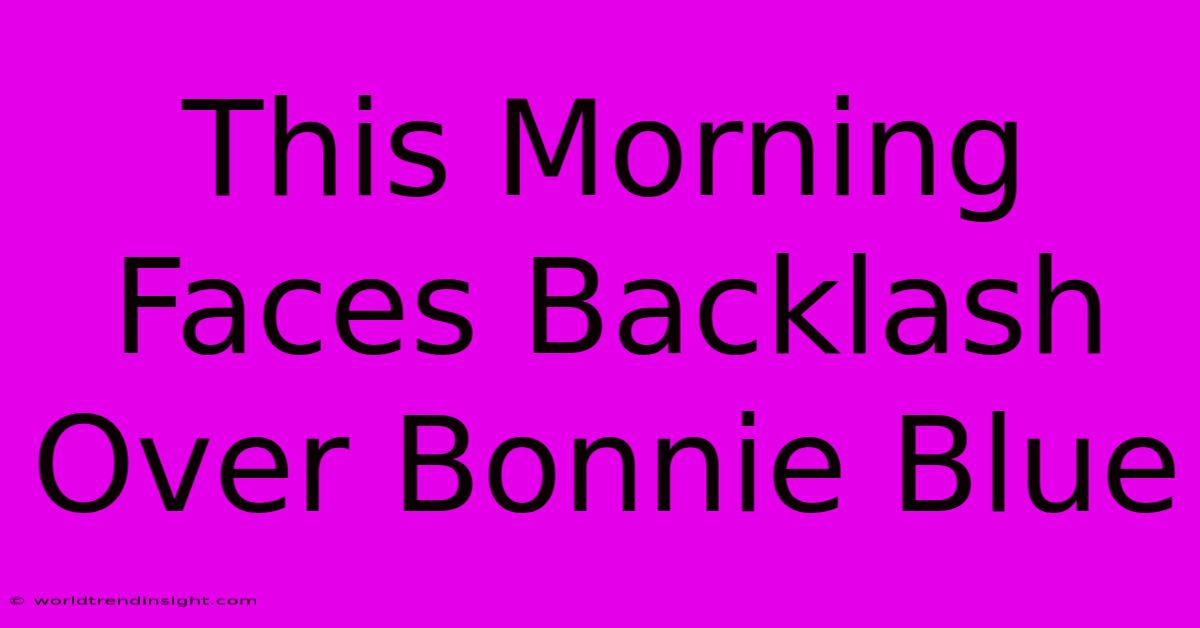This Morning Faces Backlash Over Bonnie Blue

Discover more detailed and exciting information on our website. Click the link below to start your adventure: Visit Best Website This Morning Faces Backlash Over Bonnie Blue. Don't miss out!
Table of Contents
This Morning Faces Backlash Over Bonnie Blue: A Deep Dive into the Controversy
This Morning, a beloved British breakfast show, recently found itself in the midst of a social media storm. The controversy? Their segment featuring Bonnie Blue, a controversial children's toy. Let me tell you, things got wild. I'll share my thoughts, and hopefully, we can unpack this whole messy situation.
What Happened?
Okay, so for those who missed the drama (lucky you!), This Morning featured Bonnie Blue, a doll marketed as promoting self-expression. Sounds innocent enough, right? Wrong. The problem? Many viewers felt the doll's design and marketing were overtly sexualized, inappropriate for young children. The internet exploded. Honestly, I was shocked by some of the comments. It felt like a total dumpster fire. There were accusations of the show promoting potentially harmful content for kids. Parents were NOT happy.
My Initial Reaction and Why I'm Writing About This
My jaw literally dropped when I saw the segment. I'm a mom, and I know what feels off when it comes to marketing aimed at kids. This felt… wrong. Really wrong. It's not just about the doll itself, it's about the message it potentially sends. So, I'm digging into this because, frankly, it’s important. We need to discuss how media affects children's perceptions of themselves and their bodies.
The Backlash: A Social Media Frenzy
The response on Twitter, Instagram, and Facebook was immediate and intense. The hashtag #BonnieBlueBacklash trended for days. People shared their concerns, expressed their outrage, and demanded an apology from This Morning. Honestly, it was a bit overwhelming. I was scrolling through the comments and saw everything from polite disagreement to absolute fury. Some comments were extremely harsh, and I felt for the show's producers. Criticism is one thing, but some of the negativity seemed excessive.
Analyzing the Criticism: Valid Points and Overreactions
Some criticism was definitely valid. The marketing imagery was suggestive, and the doll's design choices questionable. The show's lack of critical analysis during the segment was, in my opinion, a major misstep. They should have addressed the potential concerns head-on. Instead, it felt like they were just presenting the product without acknowledging the controversy.
However, some of the backlash felt excessive. I saw posts that bordered on bullying and harassment. We need to learn to express our concerns respectfully, without resorting to personal attacks. Remember folks, respectful dissent is key. It’s possible to disagree without being disagreeable.
Lessons Learned and Moving Forward
This whole situation highlights the need for greater scrutiny when it comes to children's products and their marketing. Media outlets have a responsibility to be mindful of the potential impact of the content they share.
For parents, this is a reminder to be vigilant. Talk to your kids about the images and messages they encounter. Engage them in conversations about body image, appropriate behavior, and media literacy.
For brands, this should serve as a cautionary tale. Think carefully about the messages you are sending and whether they align with your values.
Conclusion: Beyond the Bonnie Blue Controversy
The Bonnie Blue controversy isn't just about a single toy; it's about a larger conversation surrounding the sexualization of children in media. It's a wake-up call for us all – parents, media outlets, and brands – to be more aware and responsible. Let's hope this incident prompts a broader discussion about protecting children from harmful content. What are your thoughts? Let's discuss in the comments below.

Thank you for visiting our website wich cover about This Morning Faces Backlash Over Bonnie Blue. We hope the information provided has been useful to you. Feel free to contact us if you have any questions or need further assistance. See you next time and dont miss to bookmark.
Featured Posts
-
Su Rvers Join Vanderpump Rules Season 12
Nov 27, 2024
-
Sa Vs Sl Live Score 1st Test
Nov 27, 2024
-
Pons Moto2 Faith Conversion
Nov 27, 2024
-
Stream Sporting Cp Vs Arsenal Ucl
Nov 27, 2024
-
Election Debate Speaker Order Announced
Nov 27, 2024
